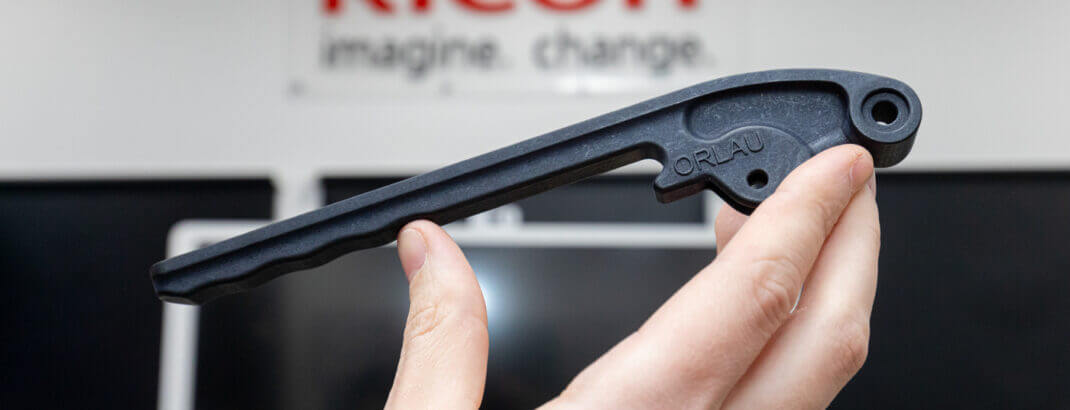Introduction
Ricoh 3D has responded to the changing demands of the modern workplace and harnessed over 80 years of manufacturing experience to provide a full range of end-to-end solutions, in the 3D printing field. As a company which prides itself on co-creation, the Ricoh 3D team regularly works with new and existing partners and customers to understand ‘pain points’ and provide innovative products and services to support businesses.
As part of Ricoh 3D’s expansion into the medical sector, since 2017, Ricoh 3D has been knowledge sharing, co-creating and partnering with ORLAU – The Orthotic Research & Locomotor Assessment Unit based at The Robert Jones and Agnes Hunt Orthopaedic Hospital (NHS), including supporting an innovative knee alignment device (KAD) which won a prestigious TCT Healthcare Application Award in 2022.
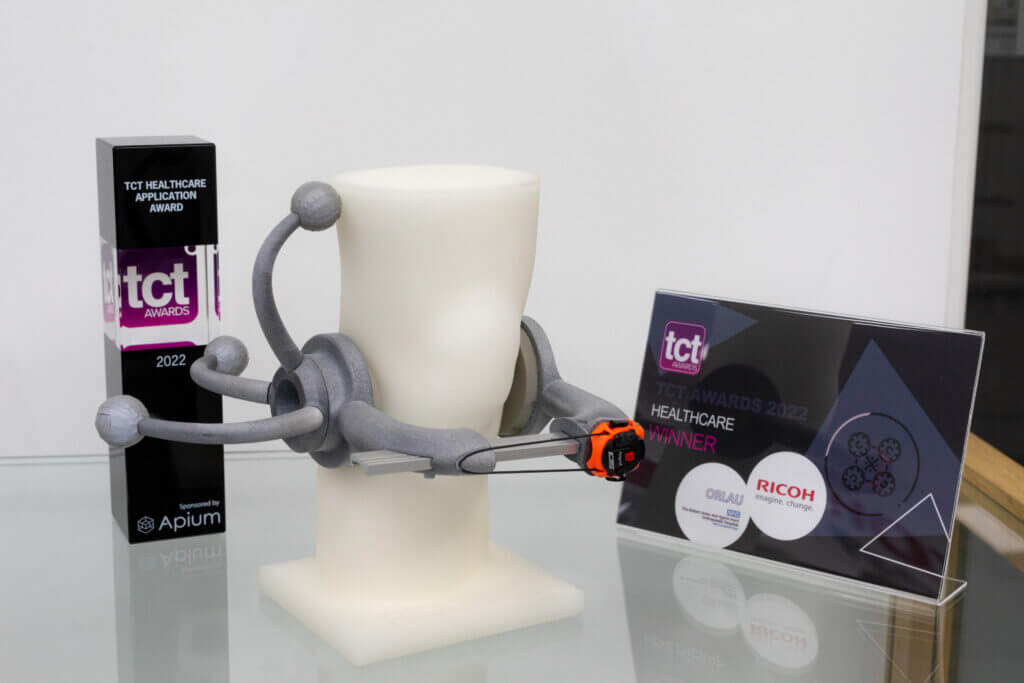
The dedicated unit was established in 1975 by Gordon Rose, an orthopaedic surgeon, to provide assessments of mobility impairment and to develop engineering solutions for patients with disabilities.
Today ORLAU continues to:
- Assess children and adults with mobility problems by gait analysis
- Advise patients and referring clinicians on treatment options and strategies
- Deliver orthoses, mobility aids and walking devices for children and adults
- Train health professionals in the fields of movement analysis and rehabilitation engineering
- Research and develop engineering solutions for mobility impairment
Application: Ankle CCD Lever
In the most recent collaboration, ORLAU and Ricoh 3D worked on the technical development, manufacture and distribution of a 3D printed ankle contracture correction device (CCD) lever [Ankle CCD Lever] manufactured using a combination of 3D printed, machined and ‘off-the-shelf’ components.
Ricoh 3D will soon be distributing the CCD lever solution in partnership with ORLAU – the technical body behind the design, to professionals and organisations trained and approved by ORLAU themselves, such as other hospitals, NHS groups, and orthotists across the UK.
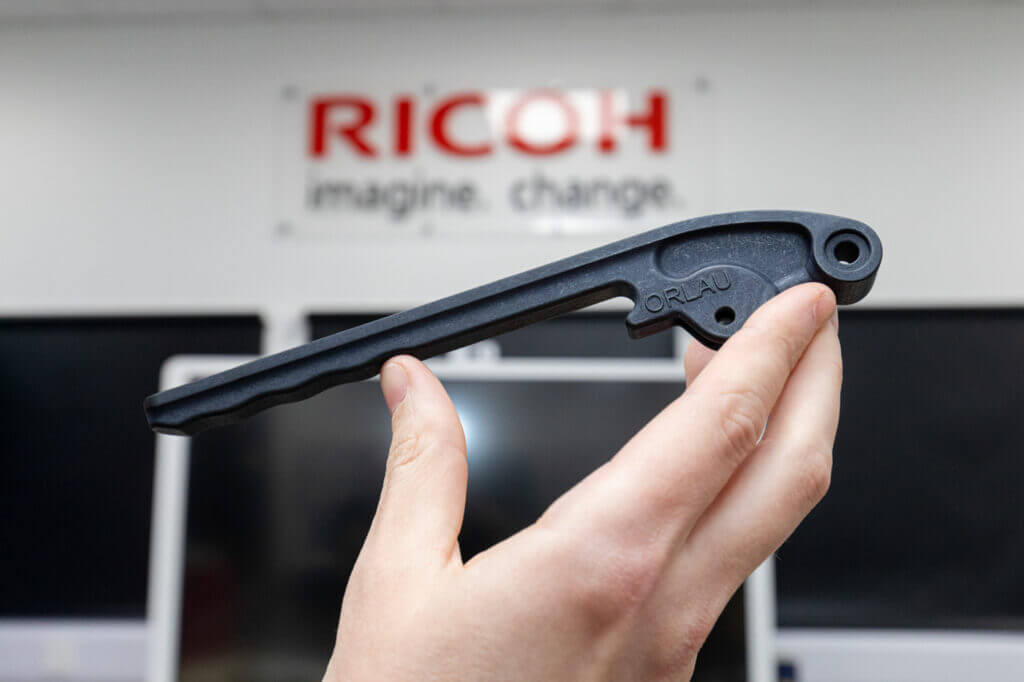
Challenge
For a number of years, ORLAU has been supplying patients with a simple ankle CCD, which applies a controlled stretch of the lower limb soft tissues – but these traditional devices can be difficult to don and doff (donning refers to putting on work clothes, gear, and equipment, while doffing means removing them). ORLAU required a more ergonomic CCD lever, which had to be a suitably usable accessory for the universal orthotic, in addition to being cost-effective, quick to manufacture and roll-out.
Solution
In response to the issue, ORLAU partnered with Ricoh 3D once again to technically develop an ankle CCD lever kit – the attachable accessory to the CCD – to assist with donning and doffing, which temporarily disconnects the stretching torque.
The adoption of 3D printing has allowed ORLAU to iterate the design multiple times in real-life test scenarios, demonstrating a more agile approach to rehabilitation needs.
Today’s bespoke device includes a 3D printed lever, manufactured by Ricoh 3D using Nylon-12 through Multi Jet Fusion technology. ORLAU pioneered the use of the innovative lever design which applies compression to a gas-spring, which in turn, applies tension to the patient’s lower limb for rehabilitation purposes. The lever improves the overall user experience by it being an integral part of the design as opposed to an additional tension-tool.
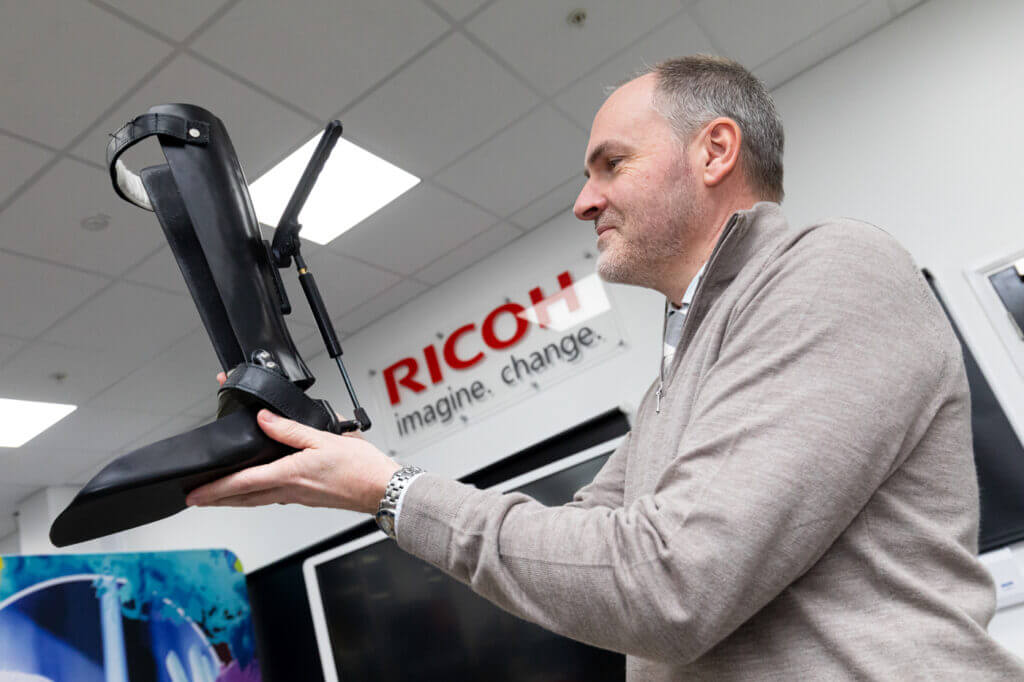
Most patients must wear the device for periods of one hour per day. For this reason, it was crucial to create a comfortable finished product, easy to use by the wearer, without the need for additional tools – a limitation of previous methods.
Results: “Success for the Ankle CCD Lever”
In addition to enhanced ergonomics and donning and doffing improvement, the lever has successfully been used to gradually apply the stretching torque using its leverage, making the process easier and more effective for rehabilitation. Furthermore, the design is such that it semi-automatically locks in the operating position due to the geometry of the components and fixings involved, which results in a simple and easy to use device for patients and/or their carers.
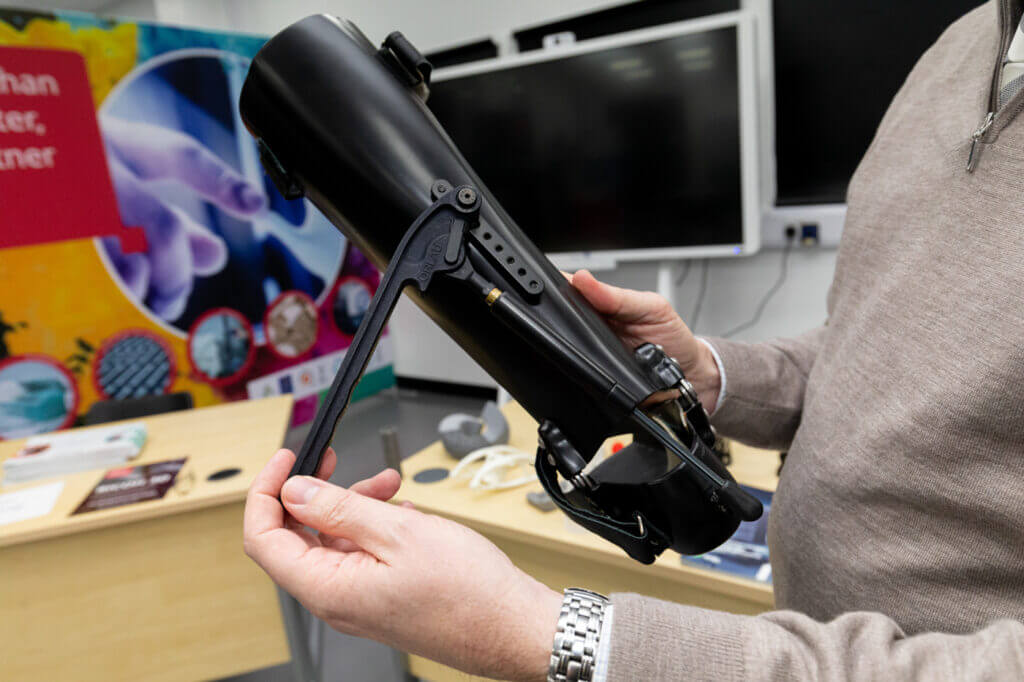
Keith Miller, Rehabilitation Engineer (ORLAU) commented: “We have issued approximately 1000 levers since the development began in 2017 and the current design is additively manufactured locally to ORLAU, by Ricoh 3D, using MJF technology.
“This cost-effective method has opened the possibility to explore the commercialisation of this product to the wider UK orthotics market, particularly focussing on supporting the NHS.”
Keith Miller, Rehabilitation Engineer, ORLAU.
“After successful development work, orthotists around the UK will soon be able to purchase a cost-effective kit of parts that can be applied to a hinged ankle-foot orthotic (AFO) shell to create a simple ankle stretching device.”
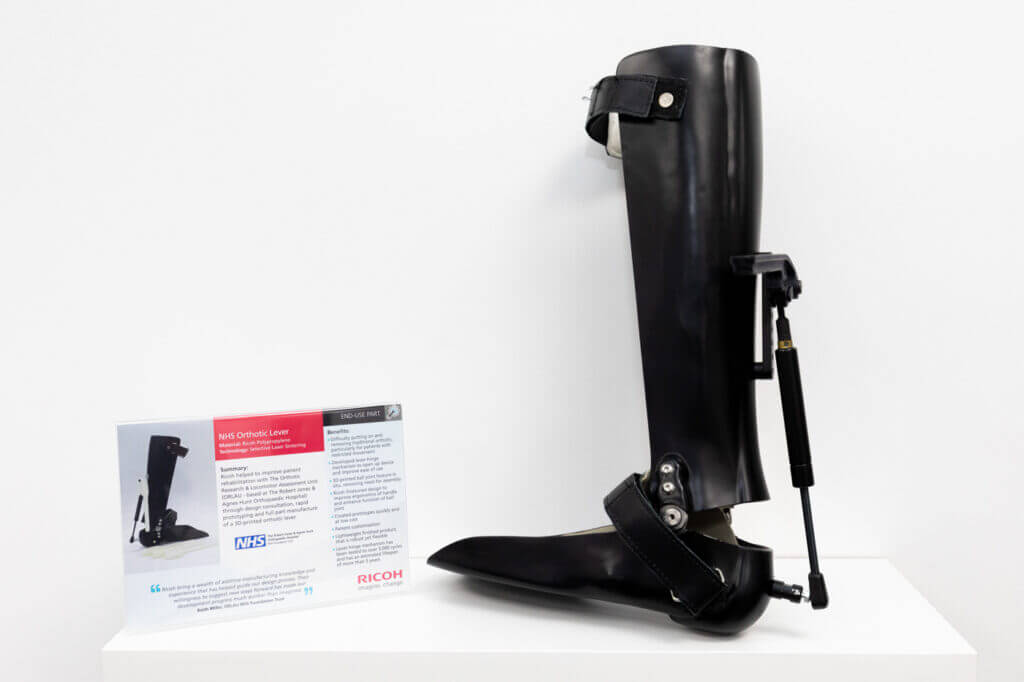
Testimonial
Said Keith Miller: “Working with Ricoh 3D has been extremely easy! They bring a wealth of knowledge about AM that we simply don’t have, nor could we hope to achieve. This made them the perfect partner to initially venture into the AM world with and they have kept us at the forefront ever since. Their expert advice and guidance around different AM methodologies has been invaluable and I’m excited to see where this approach takes us in the future.
“From a practical application point of view, there is much scope for development too… Variations of this simple lever kit could be applied to other orthotic stretching devices – a lucrative market for AM medical solutions – where similar difficulties with donning and doffing present. This initial concept could be further developed to apply on a range of similar orthotic products.”
He added: “Thanks again to the Ricoh 3D team, and we look forward to seeing how our partnership grows over the coming years, particularly as we have some exciting developments in the offing, that are likely to need producing by using AM. We harbour an ambition to tap into some of the technologies that Ricoh 3D already has access to for minimising material usage, along with maximising the benefits of CAD advancements such as generative design.”
Ongoing collaboration
Ricoh 3D’s Senior Engineer, Richard Minifie said: “Thanks to this ongoing collaboration, ORLAU has harnessed RICOH’s manufacturing heritage combined with technical expertise, and their own experience in the orthotics and rehabilitation field, to provide an innovative solution with huge potential for growth.
“I think the difficulties faced during Covid-19 highlighted that the manufacturing and medical sectors can be more closely aligned – and local, where possible, to provide bespoke manufacturing services to our National Health Service. This would enable a more agile business model and effective patient-centric care.
“By working with ORLAU on several different projects, we have reaped the rewards of a mutually beneficial relationship, knowledge-sharing and co-creating, and for us at Ricoh 3D, better understanding requirements in the medical field, including ISO-standards and purchasing policies.
“We are incredibly mindful of the need for time and cost-sensitive healthcare applications and want to work with ORLAU – and across the National Health Service – to empower them to support their customers.
“With plans to commercialise the CCD soon in 2024 via the Ricoh 3D website, we look forward to further supporting ORLAU by hosting and supporting training days for prospective hospitals and orthotic specialists; ORLAU will be able to advise and train other professionals in appropriate and effective use of the lever kit through theory sessions and practical workshops.”
For further information on training, visit the Orthopaedic Institute website:
https://www.orthopaedic-institute.org/orthotic-management-of-contractures/
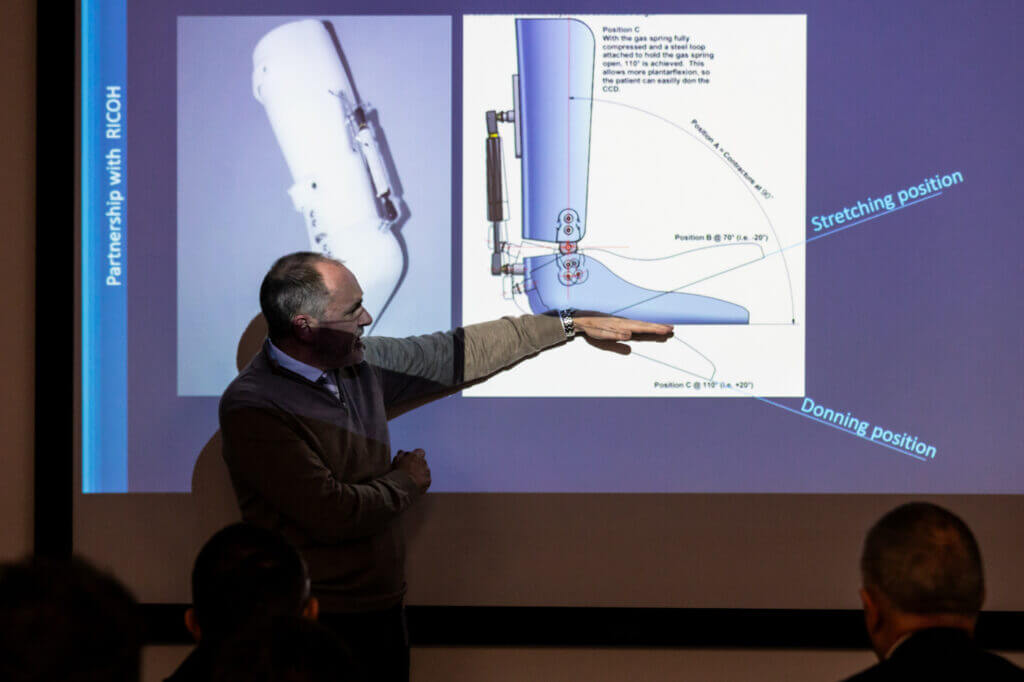
Further Reflections
He added: “At Ricoh 3D, we print hundreds or thousands of parts for all industry sectors, all of which are interesting and rewarding in their own right. However, being able to support the team at the RJAH Orthopaedic Hospital brings a notable sense of reward in helping others and co-creating innovative medical solutions – in alignment with RICOH’s global Mission-Vision of ‘Fulfilment through Work’.
“We are proud of our ongoing partnership with Keith and the wider team at ORLAU and we hope this is just the ‘tip of the iceberg’ for medical provision. We look forward to continuing our collaborations with ORLAU and other hospitals and medical professionals on life-changing solutions in health and wellbeing.”
